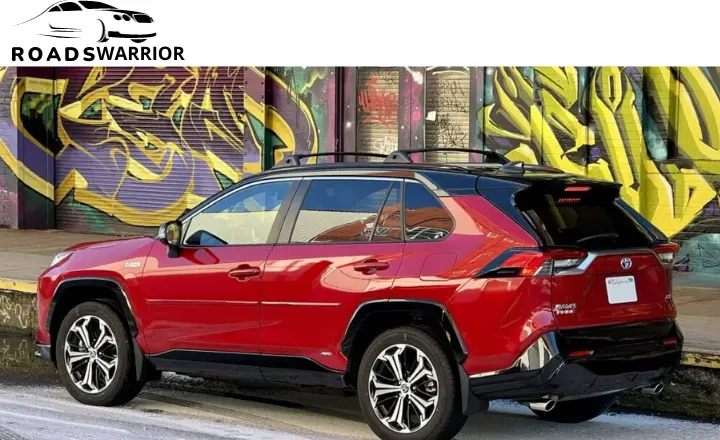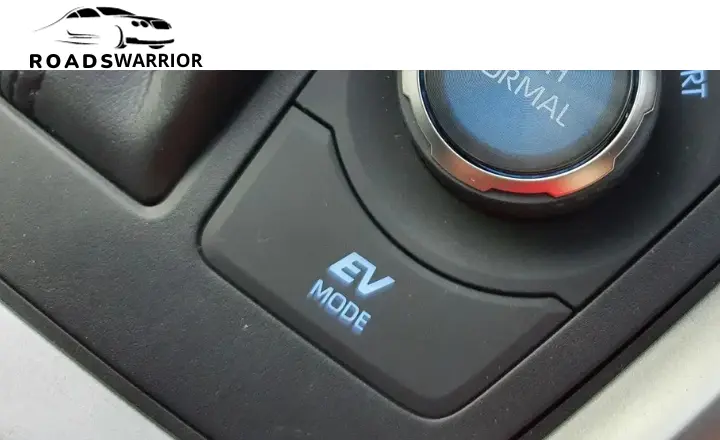The Toyota RAV4 now has two hybrid models – the regular RAV4 Hybrid and the new RAV4 Prime plug-in hybrid. Both offer an EV mode to maximize electric driving, but how exactly does the Toyota Rav4 EV mode work on each model?
This post will compare the RAV4 Prime and Hybrid EV modes to show the key differences. The RAV4 Prime’s EV mode is much more capable, allowing up to 42 miles of all-electric driving.
The RAV4 Hybrid’s EV mode, on the other hand, is limited in range and speed. Read on as we dive into the details of the Toyota RAV4 EV mode capabilities, limitations, and tips for maximizing efficiency in both hybrid models.
Toyota Rav4 EV mode

There are two Hybrid and plug-in hybrid variations of the Toyota RAV4. Despite their similarities, there is a significant distinction between the two.
The RAV4 Prime’s plug-in design provides a major advantage over the Hybrid regarding driving range. With a larger battery capacity, the Prime can travel up to 42 miles solely on electric power before switching to the gas engine. You may never have to use gasoline for most daily commutes or short trips.
On the other hand, the RAV4 Hybrid relies more on its gas engine and regenerative braking system to charge its smaller electric battery. While this provides some electric assistance and improves fuel efficiency, it falls short compared to the Prime’s true EV capabilities.
Charging options are another area where these two models differ significantly. With the RAV4 Prime’s plug-in capability, you can conveniently recharge its battery by plugging it into a standard electrical outlet or using a Level 2 charger for faster charging.
This flexibility allows you to easily top up your battery whenever needed, ensuring that you always have ample electric power available for your next journey. The RAV4 Hybrid, on the other hand, doesn’t require external charging as it primarily relies on regenerative braking and internal combustion engine assistance for recharging purposes.
You can read also about TOYOTA RAV4 HYBRID VS XLE.
RAV4 PRIME EV MODE
The RAV4 Prime premiered in America at the 2019 Los Angeles Auto Show. Sales of the 2021 model began. One notable attribute that distinguishes this plug-in hybrid electric vehicle (PHEV) is the RAV4 Prime EV mode.
HOW IT WORKS
When the EV mode is engaged on the RAV4 Prime, it opens up a world of electric-only driving. This means the gas engine takes a backseat, allowing the electric motor to do all the heavy lifting. It’s a truly exhilarating experience, knowing that you’re silently gliding down the road, leaving no trace of emissions behind.
But what happens when you need a bit more power or speed? That’s when EV mode cancels itself and seamlessly reintroduces both the gas engine and electric motor working in sync again. It’s like having two powerful forces create an unstoppable driving force.
- Certain conditions may trigger specific responses if the vehicle speed reaches or exceeds 84 mph (135 km/h).
- When instant power is required, pressing the accelerator pedal firmly or attempting to accelerate quickly can activate certain mechanisms.
- The hybrid system temperature significantly regulates performance and safety; surpassing normal parameters can cause issues.
- Higher speeds, parking under direct sunlight, driving up steep inclines, and similar scenarios can contribute to elevated hybrid system temperatures.
- If the hybrid system temperature fails to reach minimal requirements, it may lead to restricted functionality or reduced performance.
- Utilizing the cabin heater in freezing weather below approximately 14 F (-10 C) affects system operation.
- Having the windshield defogger switch on affects certain aspects of the vehicle’s functioning during use.
- Determining whether the gas engine is required depends on factors the hybrid system assesses.
- These triggers and responses ensure optimal performance, efficiency, and driver safety within specified limits.
MAXIMUM RANGE
The Toyota RAV4 EV mode range of up to 42 miles is impressive, but did you know it can exceed this range under certain conditions? When driving downhill, the regenerative braking system comes into play and helps recharge the battery.
This increases the vehicle’s overall range and eases the electric motor’s burden. It’s like getting a free energy boost as you descend those steep hills.
It’s important to note that there are factors that can decrease the EV range as well. Aggressive driving can drain the battery faster than expected, so it’s always wise to drive conscientiously and smoothly to maximize every charge.
QUICK TIPS
One way to maximize the performance of the EV mode on the Prime is to avoid sudden acceleration or deceleration. You can keep the battery at maximum capacity by driving as smoothly as possible.
It’s important to note that EV mode automatically cancels if acceleration occurs too fast. So, maintaining a steady and gradual speed ensures you get the most out of your electric driving experience.
It’s crucial to maintain adequate speeds while in EV mode. The Prime works most efficiently at normal speeds, so avoid driving too fast or too slow. By balancing and staying within an optimal speed range, you can extend your EV range and enjoy more time driving emission-free.
DECIDING BETWEEN THESE RAV4 MODELS

Although both RAV4 models are hybrids, they are extremely different, even though they may appear very similar. You must carefully examine both to determine which of these models is most appropriate for your circumstance.
Let’s go through some key distinctions you should consider before purchasing one of these cars.
DRIVING IN EV MODE
With a higher speed limit of 84 mph (135 km/h) in EV mode, compared to the RAV4 Hybrid’s limited 25 mph (40 km/h), the Prime offers a more thrilling and dynamic driving experience. Imagine effortlessly cruising down the highway in complete silence, leaving behind the noise and emissions of traditional combustion engines.
What sets the RAV4 Prime apart is its extended range of electric power. This powerful SUV can cover substantial distances solely on battery power, thanks to its larger battery size. It can easily go further than just one mile, like the RAV4 Hybrid, before relying on its gasoline engine.
This makes it ideal for those prioritizing reducing their carbon footprint while enjoying increased freedom and flexibility with their daily commutes.
VEHICLE PRICE

While the RAV4 Prime undoubtedly boasts superior fuel efficiency compared to its hybrid counterpart, potential buyers should also consider the significant difference in purchase price. It’s not just about saving gas money; it’s about assessing whether the additional cost is worth it in the long run. The RAV4 Hybrid provides an incredibly efficient and reliable option that might be more financially viable for many consumers.
When contemplating between these two models, it’s essential to consider your individual needs and budget. While increased fuel efficiency is undoubtedly advantageous, paying $10,000-15,000 more upfront for a vehicle only sometimes aligns with everyone’s financial goals. It’s crucial to assess how much you will save on fuel costs over time to determine if it offsets the initial investment.
WAIT TIMES
The high demand for RAV4 hybrid models and the resulting long wait times may seem frustrating, but it’s important to understand the reasons behind this supply-demand imbalance. The global chip shortage has significantly impacted automotive production, including the RAV4.
Chips are essential components for modern vehicles, and without an adequate supply, manufacturers have had to prioritize certain models or trim levels over others.
Moreover, labor constraints and production limits have also played a role in creating these extended wait times. The COVID-19 pandemic has disrupted supply chains and caused workforce shortages in many manufacturing facilities worldwide. As a result, automakers have needed help to meet the increasing demand for popular models like the RAV4 hybrid.
CHARGING
One of the biggest differences between the RAV4 Prime and the RAV4 Hybrid is their charging method. The RAV4 Prime offers plug-in hybrid capabilities, allowing owners to charge their vehicles using an electrical outlet or a charging station.
This option provides numerous benefits, including driving solely on electric power for shorter commutes or trips around town.
Conclusion
The Toyota Rav4 EV mode offers consumers two options with its Prime and Hybrid models. The Prime provides the convenience of all-electric driving with a longer range, making it ideal for those who prioritize sustainability and want to reduce their carbon footprint.
On the other hand, the Hybrid model offers a combination of electric and gasoline power, providing flexibility and peace of mind for longer trips. Both models have advanced technology features, safety systems, and spacious interiors, making them a practical choice for families and individuals.
Whether you opt for the Prime or the Hybrid, you can be sure you are getting a reliable and efficient vehicle from Toyota.
